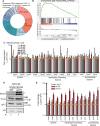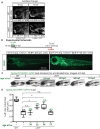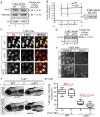DNA hypomethylation induces a DNA replication-associated cell cycle arrest to block hepatic outgrowth in uhrf1 mutant zebrafish embryos
- PMID: 25564650
- PMCID: PMC4303001
- DOI: 10.1242/dev.115980
DNA hypomethylation induces a DNA replication-associated cell cycle arrest to block hepatic outgrowth in uhrf1 mutant zebrafish embryos
Abstract
UHRF1 (ubiquitin-like, containing PHD and RING finger domains, 1) recruits DNMT1 to hemimethylated DNA during replication and is essential for maintaining DNA methylation. uhrf1 mutant zebrafish have global DNA hypomethylation and display embryonic defects, including a small liver, and they die as larvae. We make the surprising finding that, despite their reduced organ size, uhrf1 mutants express high levels of genes controlling S-phase and have many more cells undergoing DNA replication, as measured by BrdU incorporation. In contrast to wild-type hepatocytes, which are continually dividing during hepatic outgrowth and thus dilute the BrdU label, uhrf1 mutant hepatocytes retain BrdU throughout outgrowth, reflecting cell cycle arrest. Pulse-chase-pulse experiments with BrdU and EdU, and DNA content analysis indicate that uhrf1 mutant cells undergo DNA re-replication and that apoptosis is the fate of many of the re-replicating and arrested hepatocytes. Importantly, the DNA re-replication phenotype and hepatic outgrowth failure are preceded by global loss of DNA methylation. Moreover, uhrf1 mutants are phenocopied by mutation of dnmt1, and Dnmt1 knockdown in uhrf1 mutants enhances their small liver phenotype. Together, these data indicate that unscheduled DNA replication and failed cell cycle progression leading to apoptosis are the mechanisms by which DNA hypomethylation prevents organ expansion in uhrf1 mutants. We propose that cell cycle arrest leading to apoptosis is a strategy that restricts propagation of epigenetically damaged cells during embryogenesis.
Keywords: DNA methylation; DNA replication; Hepatic outgrowth; Liver development; UHRF1; Zebrafish.
© 2015. Published by The Company of Biologists Ltd.
Figures








Similar articles
-
Uhrf1 and Dnmt1 are required for development and maintenance of the zebrafish lens.Dev Biol. 2011 Feb 1;350(1):50-63. doi: 10.1016/j.ydbio.2010.11.009. Epub 2010 Nov 30. Dev Biol. 2011. PMID: 21126517 Free PMC article.
-
Nuclear Organization during Hepatogenesis in Zebrafish Requires Uhrf1.Genes (Basel). 2021 Jul 16;12(7):1081. doi: 10.3390/genes12071081. Genes (Basel). 2021. PMID: 34356097 Free PMC article.
-
DNA hypomethylation activates Cdk4/6 and Atr to induce DNA replication and cell cycle arrest to constrain liver outgrowth in zebrafish.Nucleic Acids Res. 2024 Apr 12;52(6):3069-3087. doi: 10.1093/nar/gkae031. Nucleic Acids Res. 2024. PMID: 38321933 Free PMC article.
-
Targeting the SET and RING-associated (SRA) domain of ubiquitin-like, PHD and ring finger-containing 1 (UHRF1) for anti-cancer drug development.Oncotarget. 2018 May 25;9(40):26243-26258. doi: 10.18632/oncotarget.25425. eCollection 2018 May 25. Oncotarget. 2018. PMID: 29899856 Free PMC article. Review.
-
Epigenetics, development, and cancer: zebrafish make their mark.Birth Defects Res C Embryo Today. 2011 Jun;93(2):194-203. doi: 10.1002/bdrc.20207. Birth Defects Res C Embryo Today. 2011. PMID: 21671358 Free PMC article. Review.
Cited by
-
P53 inhibitor pifithrin-α prevents the renal tubular epithelial cells against injury.Am J Transl Res. 2016 Oct 15;8(10):4040-4053. eCollection 2016. Am J Transl Res. 2016. PMID: 27829991 Free PMC article.
-
A cell cycle-dependent BRCA1-UHRF1 cascade regulates DNA double-strand break repair pathway choice.Nat Commun. 2016 Jan 5;7:10201. doi: 10.1038/ncomms10201. Nat Commun. 2016. PMID: 26727879 Free PMC article.
-
Functional Characterization of DNA Methylation in the Oligodendrocyte Lineage.Cell Rep. 2016 Apr 26;15(4):748-760. doi: 10.1016/j.celrep.2016.03.060. Epub 2016 Apr 14. Cell Rep. 2016. PMID: 27149841 Free PMC article.
-
UHRF1-mediated ubiquitination of nonhomologous end joining factor XLF promotes DNA repair in human tumor cells.J Biol Chem. 2024 Nov;300(11):107823. doi: 10.1016/j.jbc.2024.107823. Epub 2024 Sep 27. J Biol Chem. 2024. PMID: 39341501 Free PMC article.
-
Hmx1 regulates urfh1 expression in the craniofacial region in zebrafish.PLoS One. 2021 Jan 19;16(1):e0245239. doi: 10.1371/journal.pone.0245239. eCollection 2021. PLoS One. 2021. PMID: 33465110 Free PMC article.
References
-
- Anderson R. M., Bosch J. A., Goll M. G., Hesselson D., Dong P. D. S., Shin D., Chi N. C., Shin C. H., Schlegel A., Halpern M. et al. (2009). Loss of Dnmt1 catalytic activity reveals multiple roles for DNA methylation during pancreas development and regeneration. Dev. Biol. 334, 213-223 10.1016/j.ydbio.2009.07.017 - DOI - PMC - PubMed
-
- Arima Y., Hirota T., Bronner C., Mousli M., Fujiwara T., Niwa S.-i., Ishikawa H. and Saya H. (2004). Down-regulation of nuclear protein ICBP90 by p53/p21Cip1/WAF1-dependent DNA-damage checkpoint signals contributes to cell cycle arrest at G1/S transition. Genes Cells 9, 131-142 10.1111/j.1356-9597.2004.00710.x - DOI - PubMed
Publication types
MeSH terms
Substances
Associated data
- Actions
Grants and funding
LinkOut - more resources
Full Text Sources
Other Literature Sources
Molecular Biology Databases

